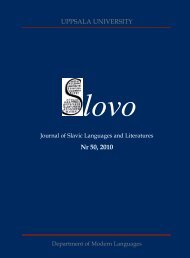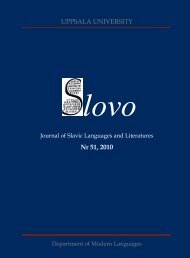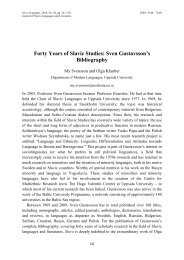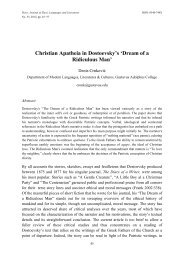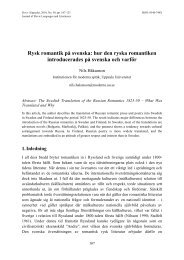Full text PDF - Index of - Uppsala universitet
Full text PDF - Index of - Uppsala universitet
Full text PDF - Index of - Uppsala universitet
Create successful ePaper yourself
Turn your PDF publications into a flip-book with our unique Google optimized e-Paper software.
Atle Grønn<br />
‘Byvalo’ and ‘used to’ as verbal quantifiers<br />
1971). 13 However, this label does not capture the essential point: the reference time is<br />
temporally bound by a higher operator. 14<br />
Before explaining the puzzle presented by the occurrences <strong>of</strong> “uvidit” and “načnet”<br />
above, let me remind the reader that the feature combination [un, upf] is problematic<br />
since the corresponding operators would normally result in the aspectual relation e <br />
s*, i.e. the event e is temporally included in the speech time, which conflicts with the<br />
assumption that the speech time denotes a point in time. This has the consequence for<br />
Russian that perfective verbs with present tense morphology in deictic con<strong>text</strong>s are<br />
coerced into a perfective future interpretation. Thus we have a special rule to the effect<br />
that an operator with the features [if, ipf] (interpretable future and interpretable<br />
perfective aspect) can check the morphological features [un, upf]. This futureperfective<br />
operator does two things: it shifts the reference time to a future time t, and it<br />
requires the event e to be temporally included in t.<br />
What happens when the feature combination [un, upf] occurs in a verb that is<br />
temporally bound by a higher operator? A reinterpretation <strong>of</strong> the perfective present as<br />
a (relative) future tense also takes place in complements <strong>of</strong> attitudes:<br />
(46) Он сказал[up, upf], что завтра сообщит[un, upf] ей свое решение. (Lev<br />
Tolstoj, “Anna Karenina”)<br />
(47) He said[up] that tomorrow he would[up] let her know his decision.<br />
(48) Han fortalte[up] at han skulle[up] meddele henne sin beslutning dagen efter.<br />
(Norwegian)<br />
If we adopt the “subjective now” metaphor from Section 2, we can easily see that we<br />
risk ending up with a similar contradiction to that encountered in deictic con<strong>text</strong>s. If<br />
the embedded perfective is combined with a present tense, i.e. is interpreted as equal to<br />
the local reference time <strong>of</strong> the complement, that is, the “subjective now”, we get the<br />
configuration e s** (where s** = the attitude holder’s subjective now). On the<br />
reasonable assumption that the “subjective now” denotes a minimal interval (a point)<br />
in time, we are again faced with a contradiction.<br />
Thus, the forward shifted interpretation <strong>of</strong> (46) makes sense. The reference time <strong>of</strong><br />
the complement is shifted to a time interval after the attitude holder’s (the agent <strong>of</strong> the<br />
saying event) own perspective time, or “subjective now”. Accordingly, we get the<br />
configuration that e t & t > s**.<br />
To sum up, in most cases, perhaps 99% <strong>of</strong> perfective non-past verb forms, the<br />
present perfective is indeed coerced into a future perfective. The utterance time (or<br />
subjective now) is too small to allow for a perfective complete event interpretation<br />
with an internal viewpoint (the event cannot be completed within the utterance time).<br />
13 Translated as “exemplifying function” (Mønnesland 1984:57): “one instance is presented as a typical<br />
example”.<br />
14 Since Russian is a non-SOT language and therefore does not transmit features from verbal quantifiers to the<br />
embedded verbs, the verbal quantifier byvalo (or byvaet) need not be overtly expressed.<br />
75



